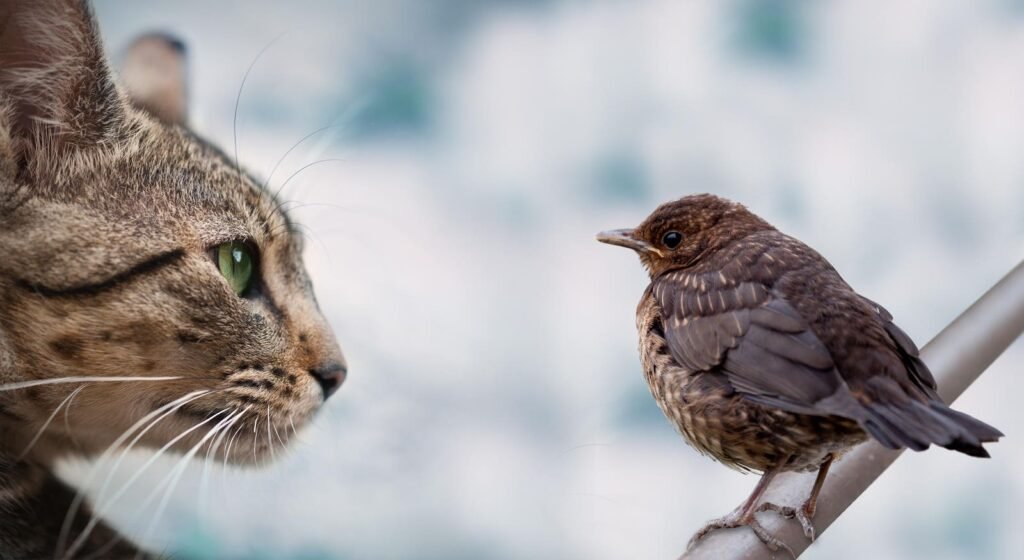Wild birds can transmit H5N1 bird flu to cats, causing severe complications and potential fatality.
The increase in bird flu cases affecting the cost of eggs is also impacting cats, necessitating precautions for cat owners.
The current strain of bird flu — avian influenza type A (H5N1) — poses a significant threat to cats, as noted by Dr. Julie Levy, DVM, Ph.D., DACVIM, a professor specializing in shelter medicine education at the University of Florida.
Dr. Levy explains, “This new strain associated with dairy cows is highly virulent. Cats exposed to it develop severe neurological symptoms within days and often succumb to the infection. Cats appear to be particularly vulnerable compared to other species.”
Neurological signs of infection include disorientation, blindness, staggering, and paralysis. Cats infected with bird flu may also exhibit respiratory symptoms ranging from mild upper respiratory issues to pneumonia.
In the United States, cats in the Midwest and West regions face the highest risk of contracting bird flu. Numerous domestic cats, including 10 in Colorado that perished, have tested positive for H5N1 bird flu. Additionally, 20 large cats at the Wild Felid Advocacy Center of Washington died from the virus late last year.
To stay informed about outbreaks, Dr. Levy recommends monitoring the U.S. Department of Agriculture’s map documenting confirmed cases of bird flu in mammals. She also suggests following the Worms and Germs blog by Dr. Scott Weese at Ontario Veterinary College’s Centre for Public Health and Zoonoses.
Dr. Julie Levy interacts with kittens at the University of Florida’s College of Veterinary Medicine.
Protecting Cats from Bird Flu
The H5N1 bird flu virus is present in feces, saliva, urine, nasal secretions, and milk, emphasizing the importance of keeping pet cats indoors to reduce the risk of exposure.
Dr. Levy advises, “Minimizing outdoor exposure is crucial because the virus is carried by wild birds, particularly waterfowl. Cats that venture outside, especially near bodies of water, are at high risk of exposure to wild birds or their droppings.”
Cleaning an indoor/outdoor cat’s paws after outdoor excursions is unlikely to be effective, according to Dr. Levy.
“It’s challenging to clean them thoroughly, and cats quickly groom themselves. Cats are meticulous groomers, so any foreign substance on their fur or paws will be ingested promptly,” she explains.
Cats’ grooming behavior increases their susceptibility to contracting bird flu.
Food consumption is another significant risk factor. Dr. Levy recommends feeding cats cooked food exclusively.
“We advise against feeding raw meat or milk, particularly poultry and dairy products, as they can transmit the virus. Terms like ‘freeze-dried’ or ‘high-pressure pasteurization’ refer to raw food products capable of transmitting the virus,” she cautions.
Earlier this year, two cats died from bird flu linked to raw poultry pet food from Savage Cat Food, leading to a recall by the New York City Health Department.
Protecting Barn Cats, Farm Cats, and Community Cats
To safeguard outdoor, free-roaming cats, including those in trap-neuter-return programs, Dr. Levy recommends feeding and caring for them in a manner that deters interaction with wildlife.
“Overfeeding cats, especially at night, can attract other wildlife species after the cats leave, leading to disease transmission. Offer only enough food for immediate consumption and avoid leaving food or trash that could lure wildlife,” she advises.
She also suggests relocating feline feeding stations away from water sources such as ponds and keeping them clear of dairy cows and poultry like chickens, geese, ducks, and turkeys.
Backyard Chickens and Bird Flu
Backyard chickens pose a risk of transmitting bird flu to pet cats.
While raising backyard chickens for eggs may seem appealing, it can pose challenges for cat owners seeking to protect their pets. However, Dr. Levy suggests it can be managed.
“Adhere to public health guidelines to confine birds and prevent interaction with wildlife, especially wild birds, by covering coop tops and pens. Restrict free-ranging activities for backyard chickens to avoid contact with areas frequented by wild birds,” she recommends.
Avoid allowing cats to mingle with backyard chickens to minimize the risk of disease transmission.
“Keep cats separated from chickens until the threat has passed,” she advises.
Responding to Suspected Cases of Bird Flu in Cats
If you suspect your cat has contracted bird flu, contact your veterinarian before visiting the clinic.
“Veterinarians need to prepare to handle such cases safely. They won’t allow you to sit in the waiting room with the cat,” Dr. Levy explains. They should wear personal protective equipment, including gloves, masks, eye protection, and shoe covers.
Individuals transporting potentially infected cats should also wear additional protective gear, she adds.
While protective measures are crucial to prevent viral spread, Dr. Levy emphasizes that surrendering cats to shelters due to suspected bird flu or fear of transmission is unnecessary.
“The likelihood of humans infecting pets, rather than the other way around, is higher with cats and dogs. Infected cats shed the virus for a brief period, so providing care for a short time before they recover is essential,” she notes.
Dr. Levy believes that severely affected cats are likely the ones currently being seen by shelters and veterinarians, suggesting that some cats may have been infected but displayed mild or no symptoms and recovered independently.
Protecting cats from bird flu not only safeguards them from severe illness and death but also reduces the risk of the H5N1 strain combining with another flu variant, potentially resulting in a more dangerous mutation.
By shielding cats from bird flu, we can prevent dual influenza infections in animals, a scenario that could lead to more harmful mutations.
Dr. Levy stresses the importance of public awareness about the significant threat posed by bird flu and the need to protect cats and communities from the virus.
Experts in animal shelter medicine from the University of Florida and other institutions have compiled a living document containing guidelines and protocols for cats suspected of H5N1 infection.
The latest updates on bird flu are available on the CDC’s bird flu page.


